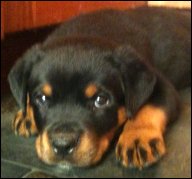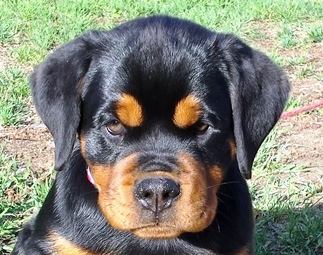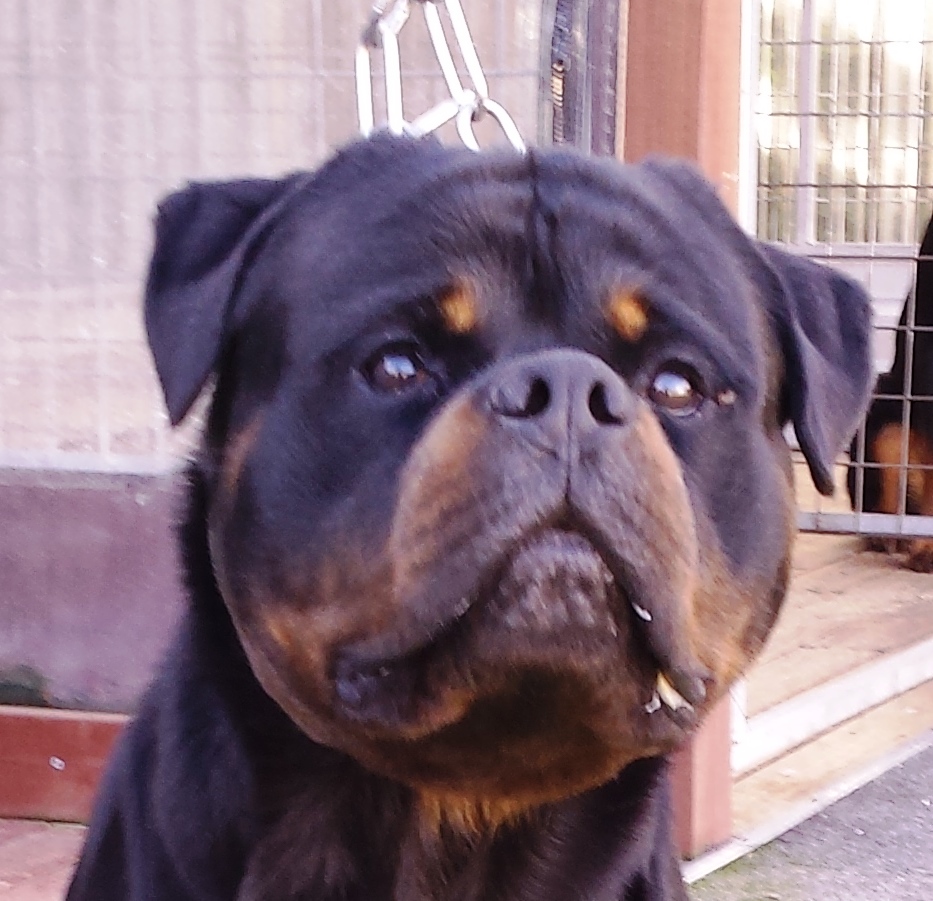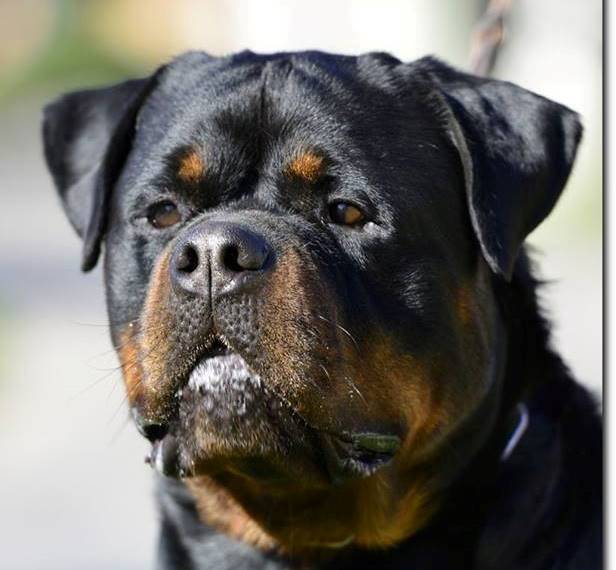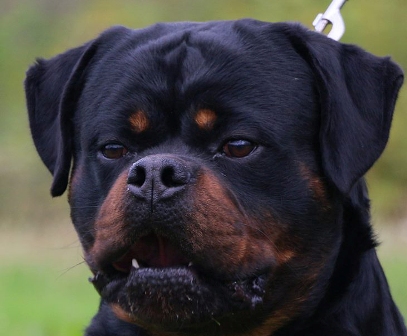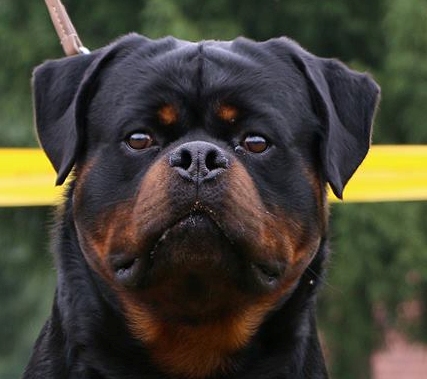The Rottweiler is considered to be one of the oldest breeds of dog. Its origin goes back to before the 1900.These dogs were kept as herder or driving dogs. They marched over the Alps with the Roman legions, protecting the humans and driving their cattle. In the region of Rottweil, these dogs met and mixed with the native dogs in a natural crossing.
 The main task of the Rottweiler now became the driving and guarding of the herds of cattle and the defense of their masters and their property. This breed acquired ist name from the old federal town of Rottweil and was known as the “Rottweil butcher’s dog”. The butchers bred this type of dog purely for performance and usefulness. In due course, a first rate watch and droving dog evolved which could also be used as a drought dog. When at the beginning of the twentieth century, various breeds were needed for police service, the Rottweilerwas amongst those tested. It soon became evident that the breed was highly suitable for the tasks set by police service and therefore they were officially recognized as police dogs in 1910.
The main task of the Rottweiler now became the driving and guarding of the herds of cattle and the defense of their masters and their property. This breed acquired ist name from the old federal town of Rottweil and was known as the “Rottweil butcher’s dog”. The butchers bred this type of dog purely for performance and usefulness. In due course, a first rate watch and droving dog evolved which could also be used as a drought dog. When at the beginning of the twentieth century, various breeds were needed for police service, the Rottweilerwas amongst those tested. It soon became evident that the breed was highly suitable for the tasks set by police service and therefore they were officially recognized as police dogs in 1910.
General Appearance: The Rottweiler is a medium to large size, stalwart dog, neither heavy nor light and neither leggy nor weedy. correctly proportioned, compact, powerful build shows his great strength,maneuverability and endurance.
Important Proposition: Length of the body, measured at the sternum (breast-bone) to the ischiatic tuberosity,shouldn’t exceed the height at the withers by, at most, 15%.
Behavior & Character: Placid and fond of children in basic disposition, very devoted,obedient, eager to work a natural and rustic appearance, behavior self assured, steady and fearless. Reacts to his surroundings with great alertness.
Cranial Region: Skull: Of medium length, the skull is broad between the ears. Viewing the Forehead line from the side it is moderately arched. Occipital bone well developed without being conspicuous.
Stop: Well defined.
Facial region Nose: Straight nasal bridge, broad at base, moderately tapered. Nose well developed, more broad than round with relatively large nostrils, always black.
Muzzle: The fore face should appear neither elongated nor shortened in relation to the cranial region.
Lips: close fitting, black, corner of the mouth not visible, gum as dark as possible.
Jaw: Upper and lower jaw strong and broad.
Cheeks: Zygomatic arches pronounced.
Teeth: Strong complete dentition (42 teeth) with scissor bite, the upper incisors closely overlapping the lower incisors.
Eyes: Of medium size, dark brown in color. Eyelids almond shaped and close fitting.
Ears: Medium sized, pendant, triangular, wide apart, set on high. The close fitting ears,set well forward, give the impression of a broad skull.
Neck: Of fair length, well muscled, slightly arched, free from throatiness, no dewlap.
Body Back: Straight, strong, sturdy.
Loins: Short, strong and deep.
Croup: Broad, of medium length, slightly rounded. Neither flat nor falling away.
Chest: Roomy, broad and deep (approximately 50% of the shoulder height) with well developed fore-chest and well sprung ribs.
Belly: Flanks not tucked up.
Tail: If docked at the first or second vertebrae. The tail may be left in its natural state.
Forequarters: Seen from the front, the front legs are straight and not placed too closely to each other. The forearm, seen from the side, looks straight. The slope of the shoulder-blade is about 45 degrees to the horizontal.
Shoulders: Well laid back.
Upper arm: Close fitting to the body.
Forearm: Strongly developed and muscular.
Pasterns: Slightly springy, strong, not straight.
Feet: Round, tight and well arched; pads hard; nails short, black and strong.
Hindquarters: Seen from behind, legs straight and not too close together. When standing free, obtuse angles are formed between the dog’s upper thigh and the hip bone, the upper thigh and the lower thigh and the metatarsal.
Upper thigh: Moderately long, broad and well muscled.
Lower thigh: Long, strong, broadly muscled at top and sinewy below, merging into sturdy well angulated hocks, not straight.
Gait:The Rottweiler is a trotting dog. In movement the back remains firm and relatively stable. Movement harmonious, steady, full of energy and unrestricted, with good stride.
Skin: Skin on the head: overall tight fitting. When the dog is alert, the forehead maybe slightly wrinkled.
Text: The coat consists of a top coat and an undercoat. The top coat is of medium length, coarse, dense and flat.
The undercoat must not show through the top coat.The hair is a little longer on the buttocks.
COLOR: Black with clearly defined markings of a rich tan on the cheeks, muzzle, throat,chest and legs, as well as over both eyes and under the base of the tail.
Arzadon Tyson on left & Jeneck’s Wotan, 2 of the most decorated dogs of all time. These 2 are gr8 examples of what we should all strive for in our breeding program.
DISQUALIFYING FAULTS:
General: Marked reversal of sexual type, i.e. feminine dogs or masculine bitches.
Behavior: Anxious, shy, cowardly, gun-shy, vicious, excessively suspicious, nervous animals.
Eyes: Entropion, ectropion, yellow eyes, different colored eyes.
Teeth: Overshot or undershot bite, way mouth; missing one incisive tooth, one canine, one premolar or one molar.
Coat texture: Very long or wavy coat.
Coat color: Dogs which do not show the typical Rottweiler coloring of black with tan markings. White markings.
Males must have two apparently normal testicles fully descended into the scrotum.
FCI Standard Height Chart To Withers
| SIZE, Centermeters | INCHES | |
| MALES |
61 – 68cm = 24 – 26 3/4in | |
| 61 – 62 | SMALL |
24 – 24 1/2
|
|
63 – 64
|
MEDIUM
|
24 3/4 – 25 1/4
|
|
65 – 66
|
LARGE (Correct height)
|
25 1/2 – 26
|
|
67 – 68
|
VERY LARGE
|
26 1/4 – 26 3/4
|
|
FEMALES
|
56 – 63cm = 22 – 24 3/4in
|
|
|
56 – 57
|
SMALL
|
22 – 22 1/2
|
|
58 – 59
|
MEDIUM
|
22 3/4 – 23 1/4
|
|
60 – 61
|
LARGE (Correct height)
|
23 1/2 – 24 3/4
|
|
62 – 63
|
VERY LARGE
|
24 1/2 – 24 3/4
|


